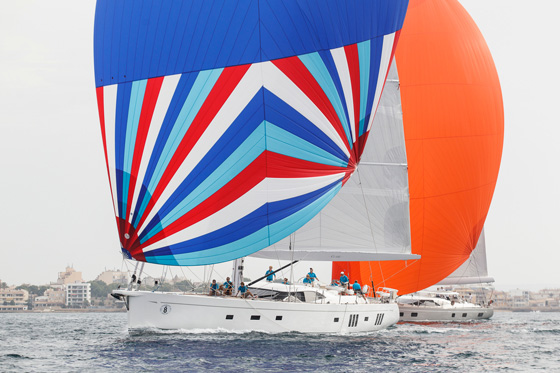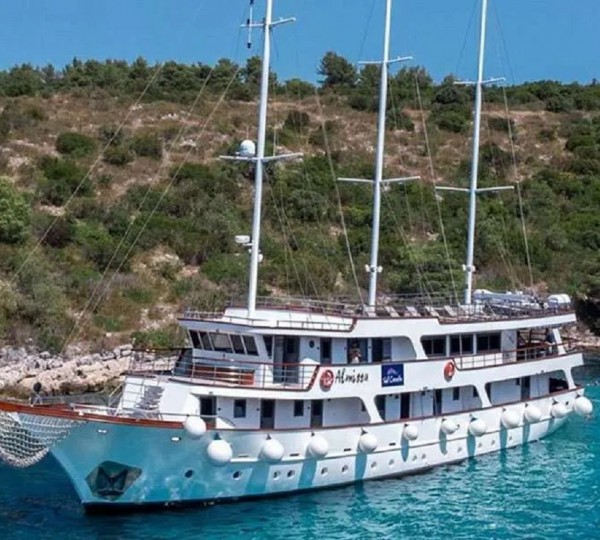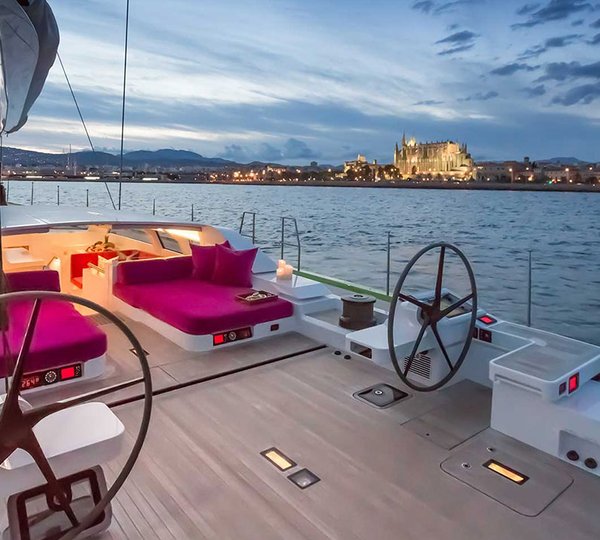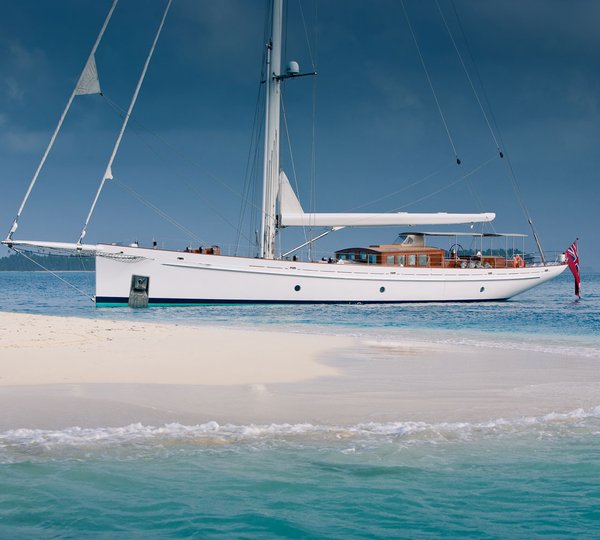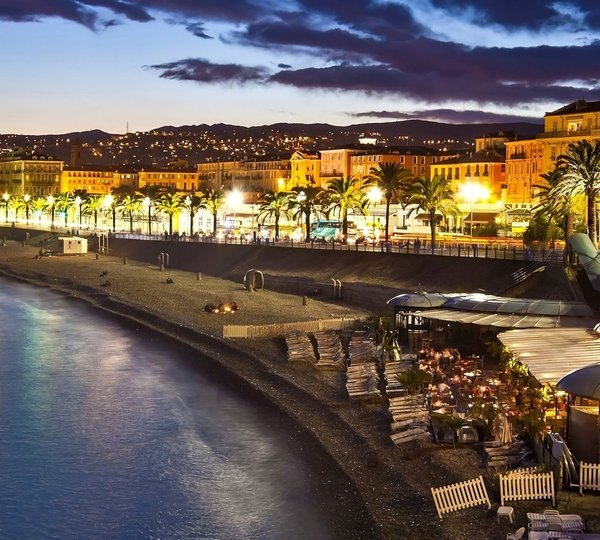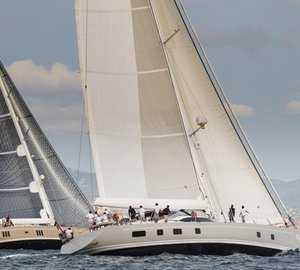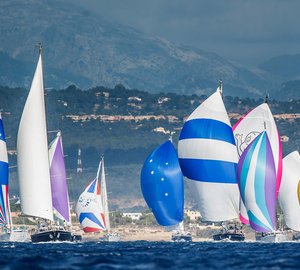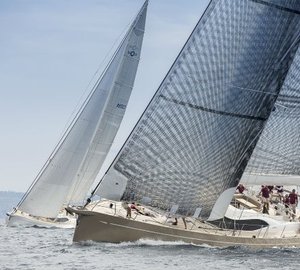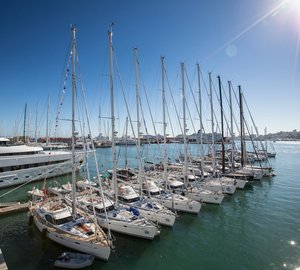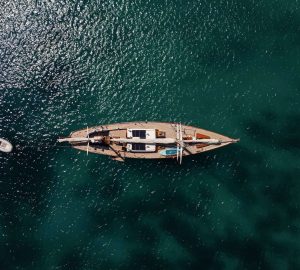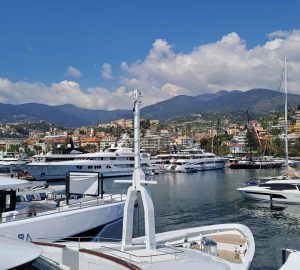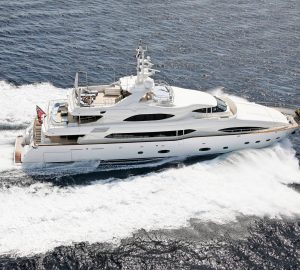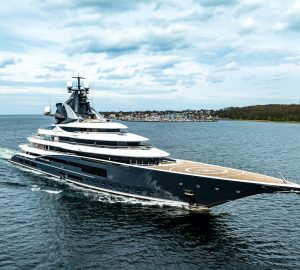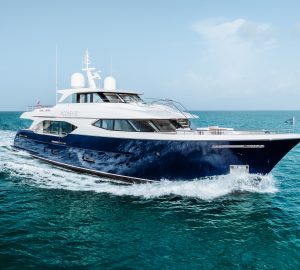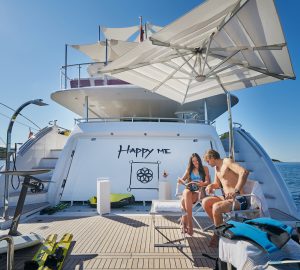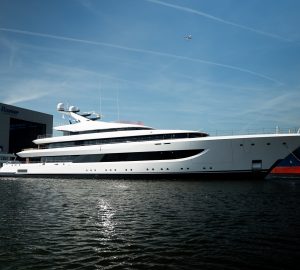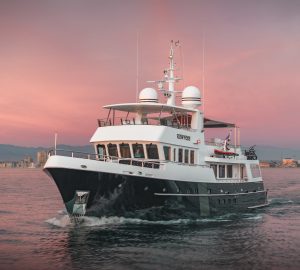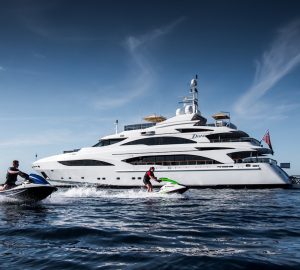Racing Day 2 of this year’s Oyster Regatta Palma was marked by a good morning challenge, with a fleet now warmed up and fighting more keenly, with closer starts as well as more grouping around the course. The expected second race of the day had to be abandoned, due to the already light NNE wind, disappearing at noon exactly as forecast.
It wasn’t gloom for all though, the postponement while waiting to see if the sea breeze filled sufficiently to race, gave the chance for an unexpectedly leisurely lunch, a swim for some in the mirror-glass 26° sea, and the novel sight of a youngster wakeboarding behind Oyster 62 sailing yacht Galloper of Hamburg, chomping across the bay at nine knots under diesel. The darndest sight, said one, and a possible whole new recreation!
The tactician’s weather vane of planes changing take-off direction to seaward indicated a rising sea breeze and hinted at possibility but the airport and other forecasting sources reported unstable winds throughout the afternoon so the Race Committee made the hard call and abandoned. As Oyster 82 superyacht Starry Night of the Caribbean’s race skipper Campbell Field said later: “Sailing these heavy boats in light winds is not good. It was right to wait for a second race, and it would have been nuts to sail in six knots, and everybody’s had fun.”
That morning race was four legs of around a left hand, two-mile sided triangle starting and finishing with a beat that began in 13 or so knots and ended in eight for most before failing. The six staggered starts divided not just by the three classes but by grouped boat sizes: Oyster 46, 53, 54, 56; 575; 62, 625; 655, 66; 72, 725, 82 and 885, 100 have met with wide approval as it takes the risk out of what would previously have seen fleets of almost 15 boats careering for the line, yet still provides excellent excitement, encouraging closer but not too close play. Comfort zones stretched but not damaged! That’s a good thing.
Tactical calls mostly turned around tricky shifts and getting them right, and in Class 1 the Oyster 885s held sway again sailing well in the lighter winds. Superyacht Karibu took first again for the third time, the 45 second, press button furling of her tennis court sized top-down furling gennaker making very light of others’ hard work! Her rival Clare, Sir Frank Chapman’s very newly launched 885, continued her good form, pulling second again. She splashed only in early August and arrived in Palma with, as Sir Frank says, “Her sails hardly seeing light of day and certainly no serious testing before yesterday. The most gratifying thing is that we’re competitive and mixing it up with the leaders.” Paul and Penny Brewer’s Oyster 100 superyacht Penelope meanwhile too had her best result yet with fourth in class, so definitely warming up.
Class 2 has clear leaders, too, with hot competition between a new and very pacey 625 and 655 Rocas, driven by owner Dario Galvao, whose team includes as well as his resident crew Ian and Cindy Smith, novice and fast learning teenage sailors Louis and Paul, sons of friend Mark also sailing.
Rocas is well set for these moderate to light days. As Dario says: “This boat sails well in 12 knots, it was definitely the right decision to go for carbon for the spars and a Park Avenue boom for the fully battened main, helps so much with good shape.” Since Dario’s 2010 purchase, Rocas has covered around 20,000 miles both sides of the Atlantic and deep into the Med in just four seasons, and Rocas has needed little more than general upkeep and a new North mainsail. Dario describes the Oyster formula as: “A very nice ratio between price and maintenance!” This is his second Palma regatta and back home in Brazil he races a hot, modern 25ft (8m) one design.
On the finish line Class-mate Oyster 625 Flying Spirit squeezed through but on corrected time Rocas maintained second spot. Flying Spirit is new this season to Rudolph Kagi. “It is new and completely different to my previous Oyster 56 Magic Spirit. Race 2 was very bad. The 3DL sails from North have very good shape but we over trimmed. We have talked now among ourselves and changed the set up and have speed. Today it was much better.”
In Class 3 John McMonigall’s Oyster 575 Zaybo returned to first after losing his hat-trick with a mark touching the previous day. He sails, he quips proudly, with “ a 100 per cent amateur crew”, and one of those, Laura Dylan, who he says used to do a bit of dinghy and small boat sailing, serves as tactician and says of John that it’s his great tell-tale concentration that puts them in line for the podium. A bit of dinghy sailing means that early days saw her racing Oppies against the now Sir Ben Ainslie! “Make good friends with good sailors,” John says with a characteristic wry smile.
John’s featured well in the regattas since his first in 2004 at which point he hadn’t raced for 20 years. “We entered not expecting to do anything but ended doing rather well. It’s really down to the basics, attention to detail, nothing fancy, standard sails, getting the genoa track settings right. The monster is getting people to understand what they’re doing.”
After mixed fortunes in Races 1 and 2 with a sixth and eleventh, regatta veteran Alan Parker’s Oyster 54 played a thrilling challenge for first until a lazyline jammed on the boom just on the last tack coming to the finish, snagging the sail half way round until the line could be cut. But this was still a good climb to second. Alan said of the day: “Good fun, well organised and a good sporting atmosphere on and off water. Had hoped for a first, were really in the groove today, see what it’s like tomorrow. We believe in continuous improvement!”
While it’s fair to say there’s a whole flotilla of Oyster sailors hoping, too, for a continuous improvement in the wind, it’s hoped also that it will fill and stay for a pursuit race after the all-important Race 4. Beyond the clear leaders of Classes 1 and 2, with the chance of a discard everything could change. So fair winds please is the call.

